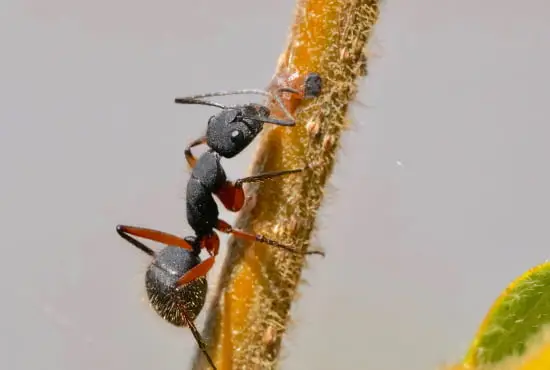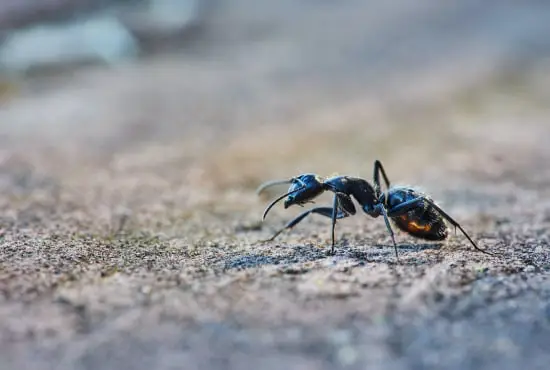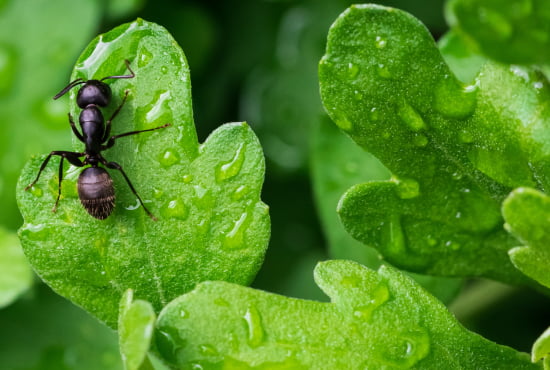Fascinating Facts About Ants
Insects are arthropods, and all arthropods have an exoskeleton. Their bodies also contain three main body parts: a head, a thorax, and an abdomen. This is in contrast to mammals, which have four (head, torso, pelvis, and limbs). Insects are bilaterally symmetrical (which means they look similar on both sides), with three pairs of legs on each segment. They also have compound eyes made up of many lenses. Ant eyes don’t move as ours do; instead of turning to track objects that enter their field of vision, they can rapidly from side to side.
Ant Habitat
We think of ants living in underground colonies, but they can live in almost any habitat on Earth, from oceans to mountaintops. The Antarctic icecap is home to a particular species of ant that lives completely underwater on floating blocks of ice. Another species lives high up in trees; it drinks plant sap and excretes sugar for tree-dwelling aphids. And those are just two among an estimated 12,000 types of ants! With such diverse environments, it’s no wonder there are thousands of different ant species roaming around. Luckily for researchers, though—the more common ones usually dominate areas like cities and suburbs.

Ant Communities
An ant colony is made up of around a million or more ants, but each one has an important function that helps to keep things running smoothly. There are three main types of ants: Queen ants lay eggs and work at the centre of their colony. Worker raise new queen when needed, defend their home, and care for younger ones, including feeding them and cleaning them. Lastly, there are male ants; they mate with queens during certain times in the year, depending on temperature and other factors. A single queen can live for 20 years in some colonies! In terms of size, ant colonies vary quite a bit based on species but generally range from less than an inch to over 16 inches long! Colonies can also be found in most climates.
Division of Labour in an Ant Colony
A single ant colony, such as a black carpenter ant colony, can have millions of members. Many of thems have specific jobs within their colony and division of labour is a big reason why they can function so efficiently. Some ants take care of new larvae while others scout for food sources. Some will even leave their colony to gather materials for construction or clean out debris in other locations. Division of labor is key to making sure that every task gets done in an ant colony. If you want your small business to be as efficient as possible, division of labor is an important part of that equation.

What Do Ants Eat?
It’s easy to see ants in their line of work, carrying food back to their nest. If you stop an ant trail and examine what it’s carrying, you’ll likely find it’s a bit of plant matter—but ants also dine on other insects (who are often much larger than they are). The workers’ jaws contain glands that secrete a sticky liquid used to trap prey; they then clamp down with their powerful jaws to administer a lethal bite. Not every species kills its food; some species depend on symbiotic relationships with aphids or other insects (or even plants) whose sap is nutritious enough for them.
Communication with Other Ants
Humans make use of radios and cell phones to communicate with each other. However, ants have a much more natural way of communicating. They leave chemicals called pheromones behind for others to smell. When another ant smells a pheromone, it takes that as a sign that an ant is trying to get its attention. How do they even sense these chemicals? Many ants have small hairs on their bodies that can pick up on many different smells, including pheromones.

How Long do Ants Live?
Average ants can live for three months, with queens living between four and six years. However, some ants live much longer: one queen in Puerto Rico lived to be 44. Many have seen ant-queens when they are older, but no one knows how long these creatures live once they become a queen. Scientists believe that there is a connection between social structures and how long they can last. Social species like ants live much longer than solitary ones such as beetles or wasps; however, there are always exceptions to every rule.
Why Are They Important?
Few animals have left as big of an impact on their environment as ants. Not only do they create habitats, but they also support other life and even help spread seeds. They are key to maintaining ecosystems, and in some cases, they control populations of harmful insects. They’ve been around for roughly 150 million years and show no signs of slowing down. We certainly don’t want to encourage insectophobia—they’re vital parts of our ecosystem—but ants deserve a little extra respect. Here are just a few fascinating facts that give us a greater appreciation for these insects

Wow, wonderful blog format! How lengthy have you ever been blogging for?
you make blogging look easy. The whole glance of your site
is magnificent, let alone the content material!
You can see similar here najlepszy sklep
Wow, incredible weblog structure! How lengthy have you been blogging for?
you make blogging look easy. The entire glance of your site is excellent, let alone the content!
You can see similar here najlepszy sklep
This is such an important reminder and one that I needed to hear today Thank you for always providing timely and relevant content
I loved as much as youll receive carried out right here The sketch is tasteful your authored material stylish nonetheless you command get bought an nervousness over that you wish be delivering the following unwell unquestionably come more formerly again since exactly the same nearly a lot often inside case you shield this hike
Dead composed content, Really enjoyed examining.